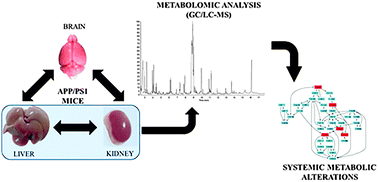Metabolomic investigation of systemic manifestations associated with Alzheimer's disease in the APP/PS1 transgenic mouse model
Abstract
There is growing evidence that Alzheimer's disease may be a widespread systemic disorder, so peripheral organs could be affected by pathological mechanisms occurring in this neurodegenerative disease. For this reason, a double metabolomic platform based on the combination of gas chromatography-mass spectrometry and ultra-high performance liquid chromatography-mass spectrometry was used for the first time to investigate metabolic changes in liver and kidney from the transgenic mice APP/PS1 against wild-type controls. Multivariate statistics showed significant differences in levels of numerous metabolites including phospholipids, sphingolipids, acylcarnitines, steroids, amino acids and other compounds, which denotes that multiple pathways might be associated with systemic pathogenesis of Alzheimer's in this mouse model, such as bioenergetic failures, oxidative stress, altered metabolism of membrane lipids, hyperammonemia or impaired homeostasis of steroids. Furthermore, it is noteworthy that some novel pathological mechanisms were found, such as impaired gluconeogenesis, polyol pathway or metabolism of branched chain amino acids, not previously described for Alzheimer's disease. Therefore, these findings clearly support the hypothesis that Alzheimer's disease may be considered as a systemic disorder.


 Please wait while we load your content...
Please wait while we load your content...